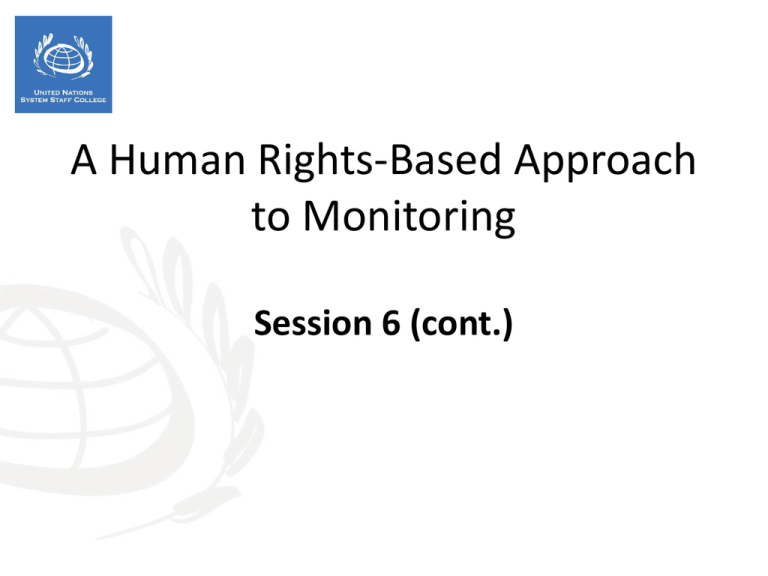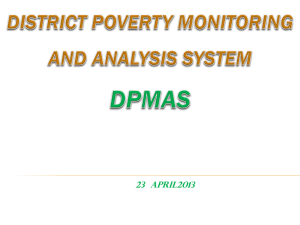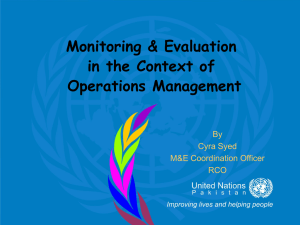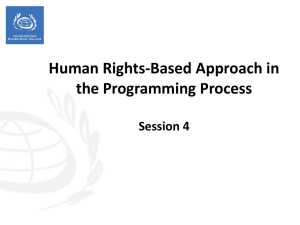6.2 HRBA to Monitoring (short)
advertisement

A Human Rights-Based Approach to Monitoring Session 6 (cont.) Monitoring vs. Evaluation Monitoring Evaluation Systematic, ongoing Systematic, periodic During programme implementation During and after programme implementation Tracking of activities and progress Judgement of merit, value or worth of a programme/project According to AWP Compared to evaluation criteria (relevance, effectiveness, impact) For short term corrective action For decision-making about future programmes Accountability for implementation Accountability for results Contributes to evaluation For office & organizational learning Conducted by insiders Conducted by impartial outsiders Are we doing things right? Did we do the right things? A Human Rights Based Approach to Monitoring • Monitoring that is sensitive to human rights applies the human rights principles and standards to inform and strengthen… – Results and indicators – Processes (both development processes and processes for monitoring and reporting) • It asks some fundamental questions – What to measure? – Who to involve? – How to measure? What to Measure? • Ideally: – Results Outputs Outcomes Impacts (often tied to National monitoring systems for the National Plans, PRSs, and MDGs) – Mechanisms and processes for programme implementation, monitoring and reporting Who to Involve? • Another way of thinking about how to apply principles of ‘participation and inclusion’ to M&E process • A HRBA – Ensures that both rights-holders and duty-bearers are involved in M&E – Will pay special attention to measures that include vulnerable groups How to Measure? • Human rights principles and standards guide the selection of indicators and the development of monitoring and reporting systems • Indicators should be chosen that: – Capture the extent to which human rights principles have been incorporated into all stages of the programme – Demonstrate how incorporating human rights standards has contributed to overall programme effectiveness (need practical example of this) • Processes must be non-discriminatory, participatory and accountable – Be wary of “elite capture” What is an indicator? A tool to measure evidence of progress towards a result or that a result has been achieved Indicators Indicators describe how the intended results will be measured - accountability Objectively verifiable measures of a particular condition They force clarification of what is meant by the result like the “fine print” of an agreement Must be accompanied by baselines and targets Baseline, Target and Achievement Performance Commitment Planned Level of Achievement Current Level of Achievement Achievement At end of period Types of Indicators Quantitative statistical measures: • Number of • Frequency of • % of • Ratio of • Variance with Qualitative judgments or perceptions: • Alignment with • Presence of • Quality of • Extent of • Level of Example: Indicators, Baseline, Target and Source of Data Outcome: By 2007, more girls in Belem Province enjoy a quality, basic education Output: 800 teachers in Belem Province can deliver the new curriculum effectively Indicator: Net enrolment ratio (M; F) Baseline: F:45% Target: F: 75% - Improvement in school test scores Indicator: # Teachers with new certification Baseline: 0 Target: 800 -Teacher proficiency reports -Improvement of school satisfaction ratings Source of Data -MICS (survey) -Annual school test scores report Source of Data: - MECYS EMIS -School satisfaction surveys HRBA and indicator development • Inclusiveness: Do your indicators capture the experience of vulnerable and marginalised groups? Can your indicators be disaggregated? • Ownership: Have RHs and DBs contributed to the development of the indicators? Do they have confidence in the indicators chosen? • Clarity: Are they clear and understandable to all audiences, including vulnerable and marginalised groups? Group Work (30 m) In Groups… • Develop 2 indicators for each outcome and contributing output • Add to your results framework… Outcome Output Indicators Indicators Output Indicators Group Work (15 m) In Groups… • Choose 1 principle from… – Equality and non-discrimination – Participation and inclusion – Accountability and rule of law • Make up to 3 changes in your results framework (results and indicators) to reflect the principle • Be ready to present in plenary… Human Rights Principles • Universality and inalienability • Indivisibility • Interdependence and Interrelatedness • Equality and nondiscrimination • Participation and inclusion • Accountability and rule of law Gallery Your opportunity to “visit” other groups and give feedback Reflect on… – The logical flow of results and use of change language – The SMART-ness of the framework, particularly the formulation of indicators, assumptions and risks – The linkage between the results framework and the human rights-based analysis. Is it intuitive? Do the results respond to the underlying and root problems revealed by the analysis? Do the outcomes show changes in the performance of rights-holder to claim their rights, duty-bearers to meet their obligations? Do the outputs address identified capacity gaps? !! Remember - leave comments behind on post-it notes.











